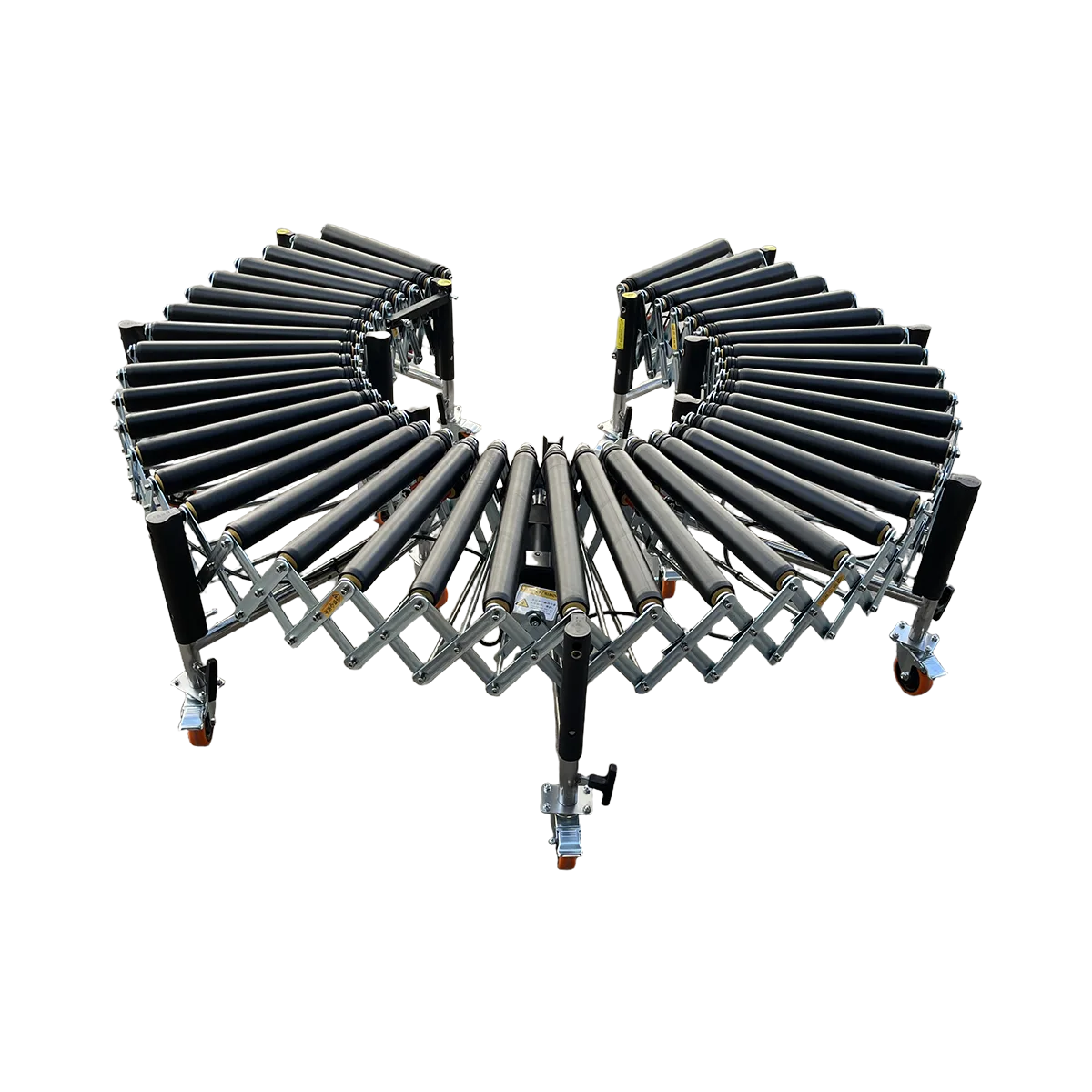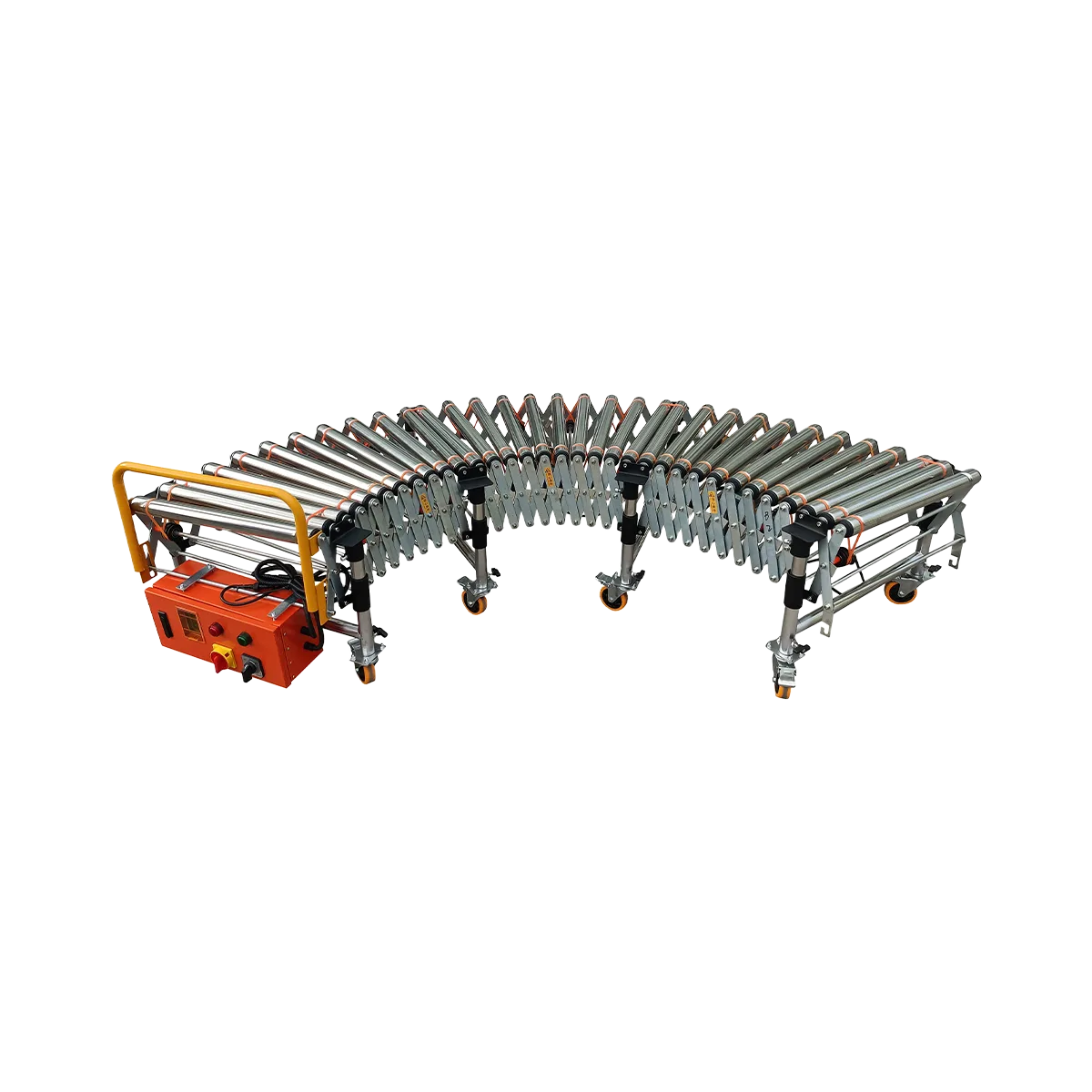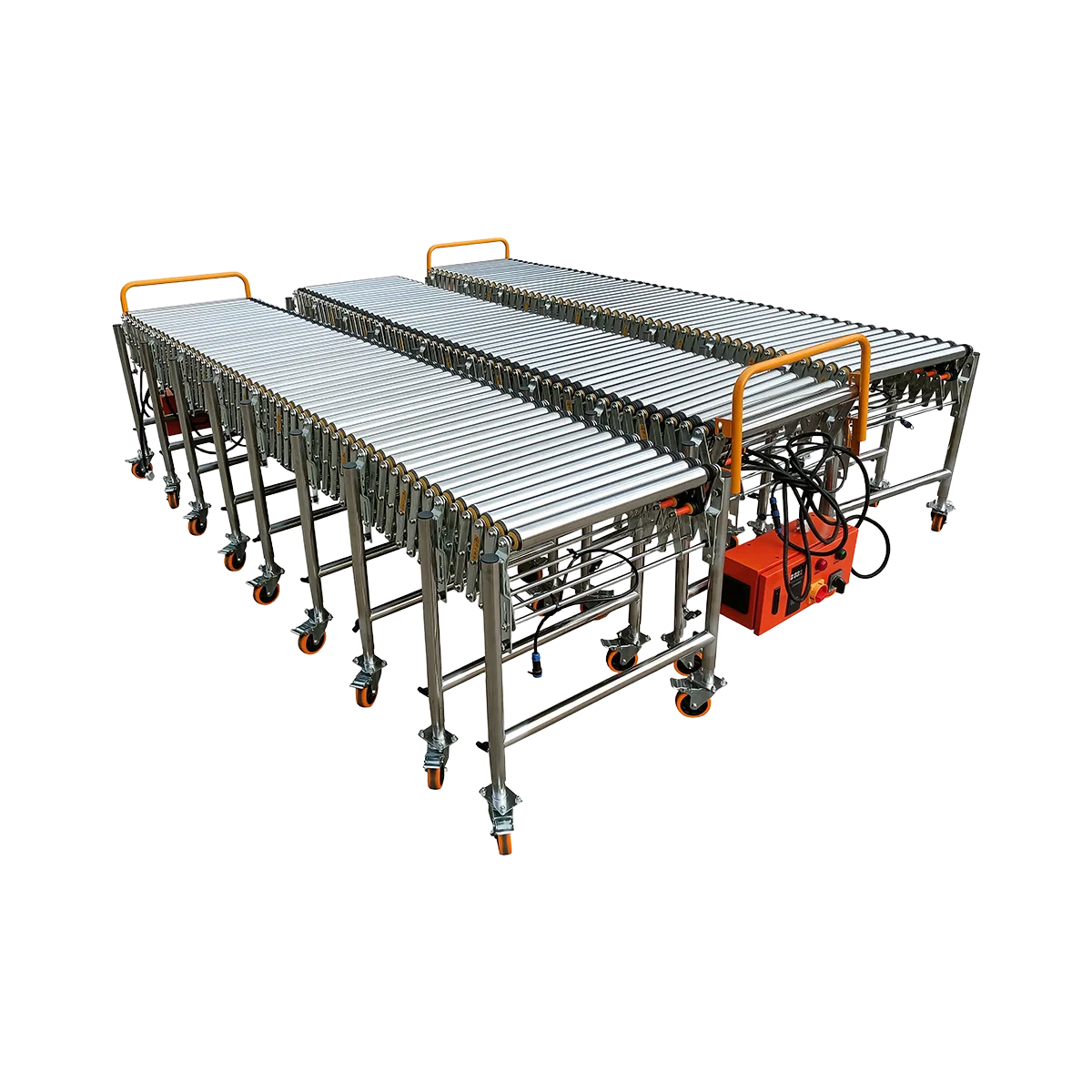Adjustable Roller Conveyor
An Adjustable Roller Conveyor system is a versatile and indispensable tool for warehouses, distribution centers, and manufacturing facilities, designed to significantly enhance the speed and safety of moving goods.
Related Products
- Powered Rubber Roller Conveyor – Multi-wedge Belt Driven – 1100 mm/SectionCollapsed Length
560 mm
Extended Length1100 mm
Load Capacity120 kg/m
Applicable GoodsFlat-bottomed Goods
Bagged Goods
- Powered Roller Conveyor – O-shaped Belt Driven – 1500 mm/SectionCollapsed Length
525 mm
Extended Length1500 mm
Load Capacity80 kg/m
Applicable GoodsFlat-bottomed Goods
- Powered Roller Conveyor – Multi-wedge Belt Driven – 2000 mm/SectionCollapsed Length
700 mm
Extended Length2000 mm
Load Capacity100 kg/m
Applicable GoodsFlat-bottomed Goods
- Powered Roller Conveyor – Multi-wedge Belt Driven – 3000 mm/SectionCollapsed Length
1050 mm
Extended Length3000 mm
Load Capacity80 kg/m
Applicable GoodsFlat-bottomed Goods
In today’s fast-paced logistics environment, efficiency at the loading dock is paramount. An Adjustable Roller Conveyor system is a versatile and indispensable tool for warehouses, distribution centers, and manufacturing facilities, designed to significantly enhance the speed and safety of moving goods. These conveyors bridge the critical gap between transport vehicles and internal handling systems, offering unparalleled flexibility with their ability to extend, retract, and adjust in height. Naili Conveyor specializes in providing robust Adjustable Roller Conveyor solutions that cater to a wide array of materials, from lightweight parcels to heavy-duty cartons and soft packaging. By minimizing manual handling, reducing turnaround times, and seamlessly integrating into existing workflows, our conveyors are engineered to optimize your entire loading and unloading process. Whether you need a simple gravity-fed line or a sophisticated powered system, understanding the capabilities of an Adjustable Roller Conveyor is the first step towards a more productive and ergonomic workspace.
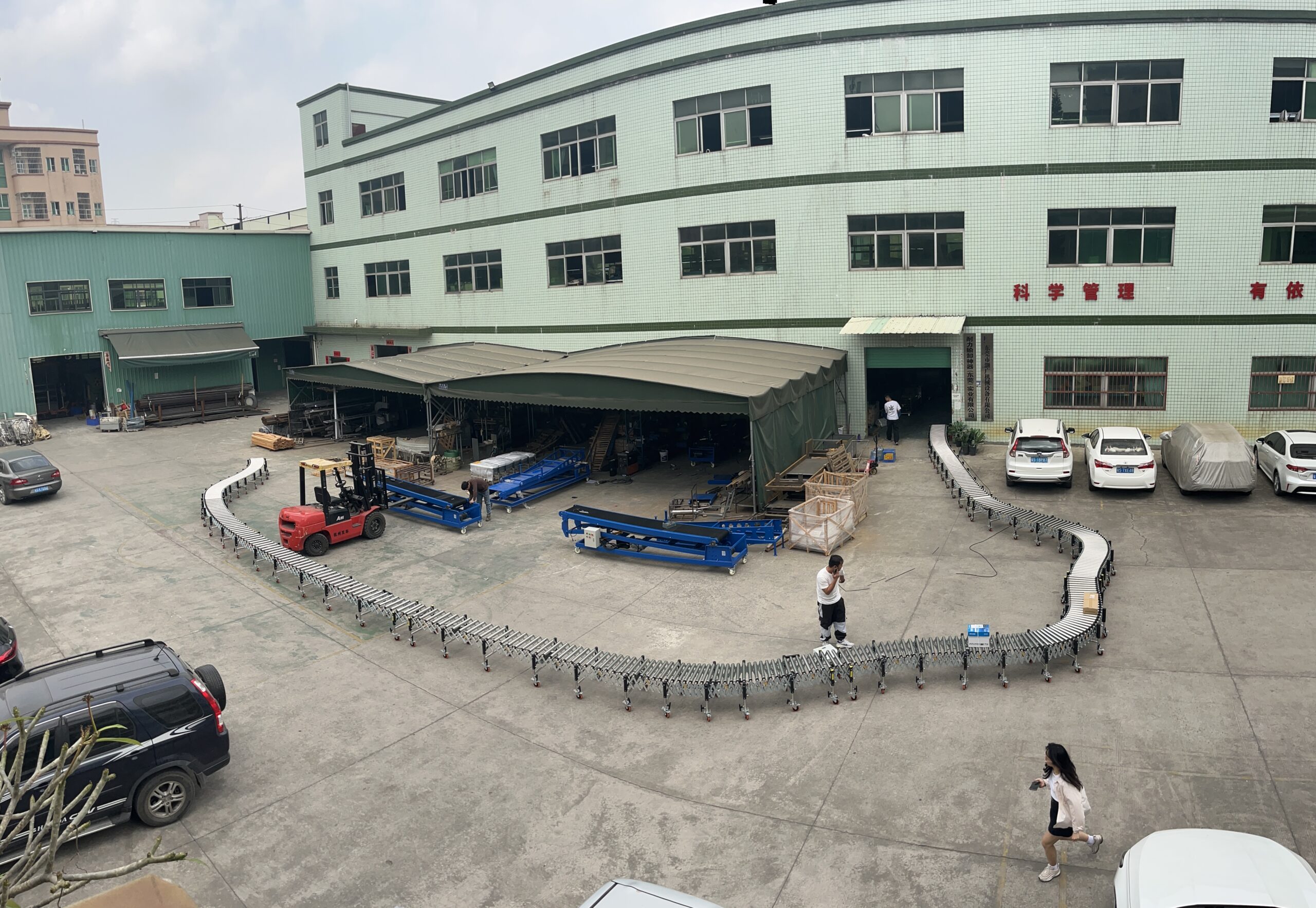

The Critical Role of Flexibility in Modern Loading Docks
Loading docks are dynamic environments where conditions change with every arriving and departing truck. Vehicle bed heights vary, available floor space fluctuates, and the types of goods handled can differ significantly from one shipment to the next. This is where the inherent flexibility of an Adjustable Roller Conveyor truly shines.
Consider these common dock challenges:
- Variable Reach Requirements: Trucks and containers come in different lengths. A fixed conveyor might be too short for some or obstruct space when not in use. Adjustable Roller Conveyor systems, with their telescoping design, can extend deep into a trailer or container and retract compactly when the job is done.
- Height Discrepancies: Matching the conveyor height to the truck bed, dock leveler, or an existing takeaway powered conveyor line is crucial for smooth material flow and operator ergonomics. Adjustable legs on these conveyors allow for precise height tuning for minor adjustments or creating slopes. For significant lifts to truck bed height combined with internal reach, they are often paired with systems like our Hydraulic Conveyor.
- Diverse Product Handling: From sturdy boxes to delicate soft packs, the ideal conveying surface and method can change. Adjustable Roller Conveyor systems offer options like steel rollers, rubber-coated rollers, and even skate wheels, along with choices for gravity or powered movement.
- Dynamic Layouts: Loading docks often serve multiple purposes, and a permanent conveyor installation might not be feasible. Mobile Adjustable Roller Conveyor units equipped with heavy-duty locking casters can be easily repositioned or stored, adapting to the day’s specific needs.
By addressing these challenges, an Adjustable Roller Conveyor not only improves operational efficiency but also contributes to a safer working environment by reducing the need for manual lifting and carrying over awkward distances.
Core Engineering and Design Features of Naili’s Adjustable Roller Conveyors
Naili Conveyor’s Adjustable Roller Conveyor systems are built with durability, flexibility, and ease of use in mind. Key features across our range include:
| Feature | Description & Naili Implementation | Benefit for Your Operations |
| Telescoping Frame | Nested sections, often made from Q345 steel, glide smoothly on durable bearings. Naili offers impressive extension ratios, typically 1:3 and up to 1:5 on some models like the Gravity Skate Wheel Conveyor. | Provides significant reach into trailers while allowing compact storage, maximizing floor space. |
| Adjustable Height Legs | Robust steel legs (often 201 stainless steel) with options for manual screw jack adjustment or simple sleeve designs. Standard height ranges like 450-680mm, 550-820mm, 750-1200mm, and 900-1500mm are common. | Allows for creating slopes for gravity flow or matching heights with other dock-level equipment. For substantial lifts to truck beds, integration with a Medium Hydraulic Conveyor is recommended. |
| Durable Rollers | Options include galvanized steel rollers (standard for Gravity Roller Conveyor and Powered Roller Conveyor), 201 stainless steel for wet environments, or PVC-coated rollers on the Powered Rubber Roller Conveyor. Diameters typically range from 38mm to 54mm. | Long service life, suitable for various package types, and corrosion resistance where needed. |
| Drive Mechanism Choice | Gravity-fed (no power needed), O-belt drive (for lighter loads, quieter operation), or robust Multi-wedge belt drive (for heavier loads, higher torque). Speed is often variable (e.g., 0-40 m/min) on powered models. | Select the most energy-efficient and effective drive for your specific load types and throughput requirements. |
| Modular Connectivity | Sections are designed with simple, secure coupling mechanisms (e.g., pin-and-eye links) at each end. | Allows for easy extension of the conveyor line by joining multiple sections to achieve desired lengths, often exceeding 20 meters. |
| Mobility & Stability | Equipped with heavy-duty, 4-inch swivel casters that include full braking mechanisms. | Easy to maneuver and reposition by one or two operators, yet locks securely in place during operation for safety. |
| Control Systems (Powered) | User-friendly control panels typically include Forward/Reverse, Emergency Stop, and Speed Control (via VFD). Electrical components meet relevant national standards, including leakage protection. | Simple, intuitive operation for staff, enhancing safety and control over material flow. Workers require minimal training. |
These features combine to create a conveying solution that is not just adjustable, but also reliable and easy to integrate into your daily operations.
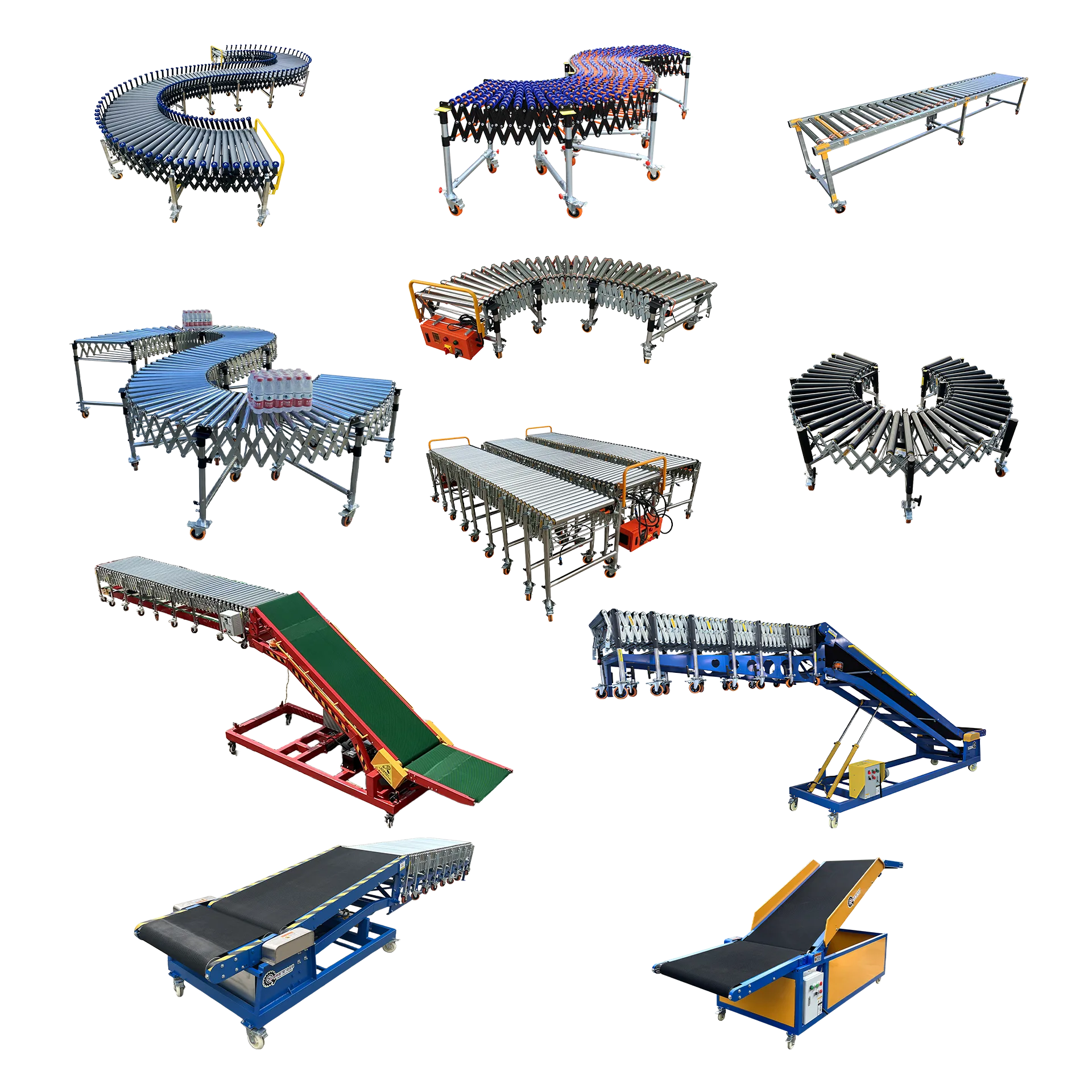

Exploring Naili’s Range of Adjustable Roller Conveyors
Naili Conveyor offers several distinct types of Adjustable Roller Conveyor systems, each tailored to specific needs and load characteristics. Understanding these differences will help you select the optimal solution.
1. Gravity Roller Conveyor
This is the simplest and most economical type of Adjustable Roller Conveyor. It relies on a slight downward slope (typically 2-5 degrees) to allow goods to move via gravity.
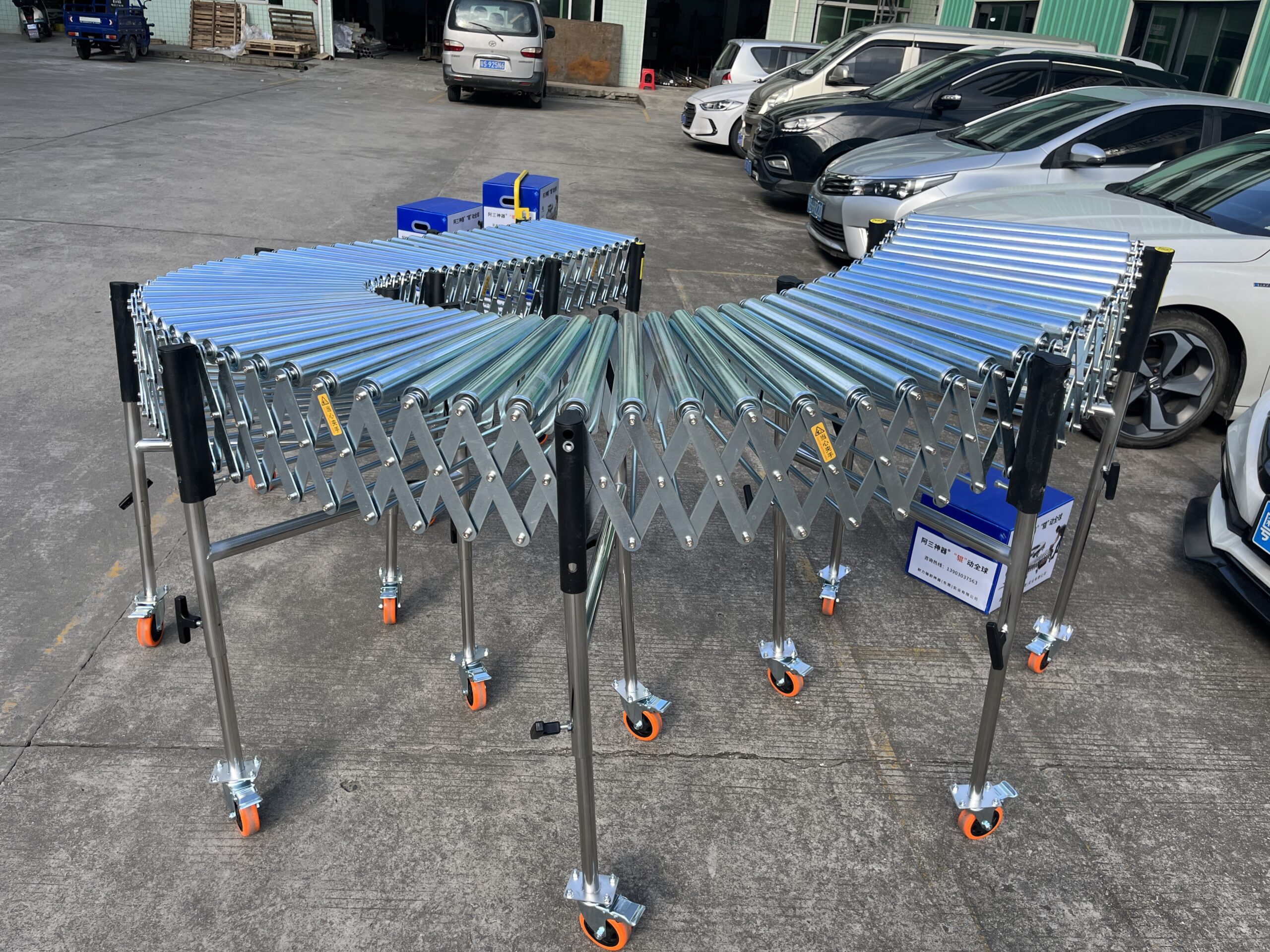

- Key Features:No power required, making it energy-efficient and quiet.
- Available with 50mm diameter rollers (80 kg/m capacity, 1500mm/section extended length) or 38mm diameter rollers (50 kg/m capacity, 1700mm/section extended length).
- Ideal for unloading applications where a natural decline can be established from a dock to a lower area or for short transfers.
- Even on a horizontal plane, goods can be easily pushed along, saving significant effort, classifying it also as a type of manual conveyor.
- Best Suited For: Flat-bottomed cartons, totes, and packages in environments where power access is limited or noise reduction is a priority. Commonly used for short-distance transfers and as feeders to other systems at dock level or with slight inclines.
2. Powered Roller Conveyor
When level transport, controlled speed, or bi-directional movement is necessary, the Powered Roller Conveyor is the answer. These units feature integrated motors.


- Key Features:O-Shaped Belt Driven: Typically for lighter to medium loads (e.g., 80 kg/m), offering quieter operation. Naili’s 1500mm/section model is a popular choice.
- Multi-Wedge Belt Driven: Provides higher torque and load capacity (e.g., 80-100 kg/m). Available in 2000mm/section and 3000mm/section models. This drive is more robust for demanding applications.
- Adjustable speed (often 0-40 m/min) via a variable frequency drive (VFD).
- Forward and reverse functionality.
- Best Suited For: Horizontal conveying, controlled flow rate, accumulation, and integration with automated systems. Essential when a consistent speed or slight incline movement is needed. Remember, intentionally jamming goods on these conveyors can cause drive belt wear.
3. Powered Rubber Roller Conveyor
Specifically designed for handling items that might slip or be damaged by standard steel rollers, such as soft packaging, polybags, or irregularly shaped items.
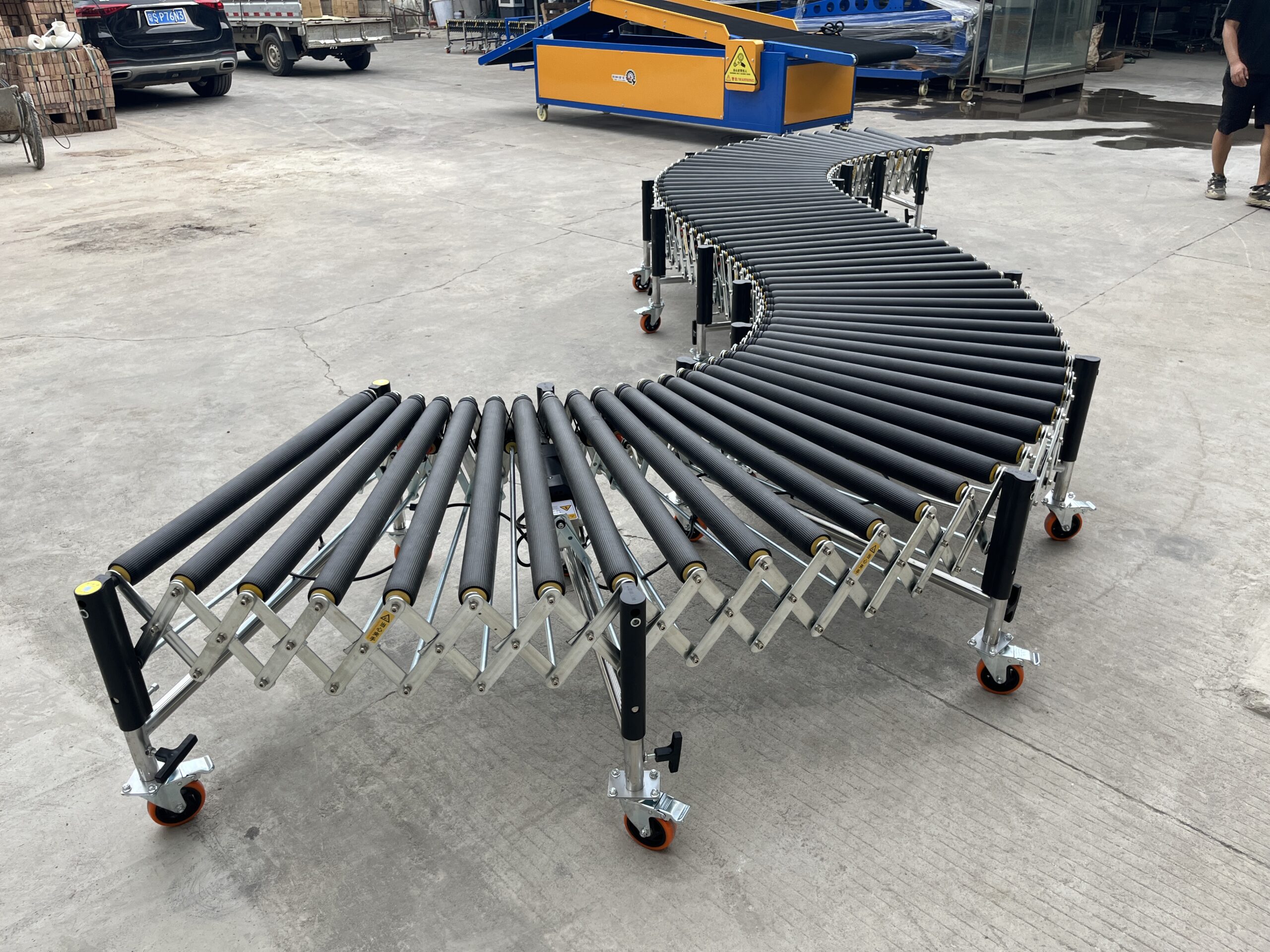

- Key Features:PVC-coated rollers (e.g., 54mm diameter) provide enhanced grip and cushioning.
- Typically uses a robust Multi-wedge belt drive system.
- High load capacity (e.g., Naili’s model handles 120 kg/m).
- Operates at speeds around 40 m/min.
- Best Suited For: Postal services, apparel distribution, and any application involving bagged goods or delicate packages that require a gentler, more secure conveying surface.
Selecting the Optimal Configuration for Your Needs
Choosing the right Adjustable Roller Conveyor involves considering several factors beyond just the type:
- Load Capacity: Always select a conveyor with a rated capacity that comfortably exceeds your heaviest typical load per meter. Consider both uniformly distributed loads and point loads.
- Conveyor Length: Measure the maximum reach required. Naili’s modular design allows you to connect sections to achieve nearly any length. For example, a 21-meter requirement can be met with seven 3-meter sections of roller conveyor.
- Conveyor Width: The usable width should be at least 50-100mm wider than your widest package to prevent snagging. Common widths are 500mm, 600mm, and 800mm.
- Roller Diameter and Pitch: Larger diameter rollers are generally for heavier loads. Roller pitch (center-to-center distance) should be such that at least three rollers are under your shortest package at all times.
- Operating Environment: For damp or corrosive environments, consider 201 stainless steel rollers or frames. Standard models often use galvanized steel.
- Power Requirements (for powered models): While 380V three-phase is recommended for optimal performance, Naili can configure powered units for 220V single-phase power upon request.
Seamless Integration with Other Naili Conveyor Systems
One of the key strengths of Naili’s Adjustable Roller Conveyor line is its ability to integrate with other types of material handling equipment to create comprehensive logistics conveyor solutions.
- With Hydraulic Conveyor Systems: This is a key combination for effectively loading/unloading vehicles without a fixed dock or where significant height differences exist. An Adjustable Roller Conveyor (either gravity or powered) can be placed on the upper support frame of a Medium Hydraulic Conveyor or Large Hydraulic Conveyor. The hydraulic unit lifts the roller conveyor section to the vehicle bed height, and the roller conveyor then extends into the trailer or container. This solves the problem of adjustable legs on roller conveyors alone not reaching full truck height and providing seamless entry. The bottom of a hydraulic conveyor can also connect to a roller conveyor system at ground level, creating a continuous flow from a warehouse area directly into a truck via the lifted section.
- With Telescopic Conveyor Systems: While a Telescopic Conveyor itself is a powerful solution for fixed dock applications, its efficiency can be enhanced by feeding it with an Adjustable Roller Conveyor. This is particularly useful for transporting goods from a staging area within the warehouse to the tail end of the telescopic unit, ensuring a continuous flow.
- With Gravity Skate Wheel Conveyor Systems: For creating curves, navigating tighter spaces, or for very lightweight, flat-bottomed items, a skate wheel conveyor section can be easily connected to an Adjustable Roller Conveyor
- Important Compatibility Note: As highlighted in our product guidelines, Telescopic Conveyor and Hydraulic Conveyor systems cannot be directly combined or mounted onto each other. They are designed as standalone solutions for different primary applications. However, they can work in sequence, often linked by an intermediate Adjustable Roller Conveyor if the workflow demands transitioning between their functionalities.
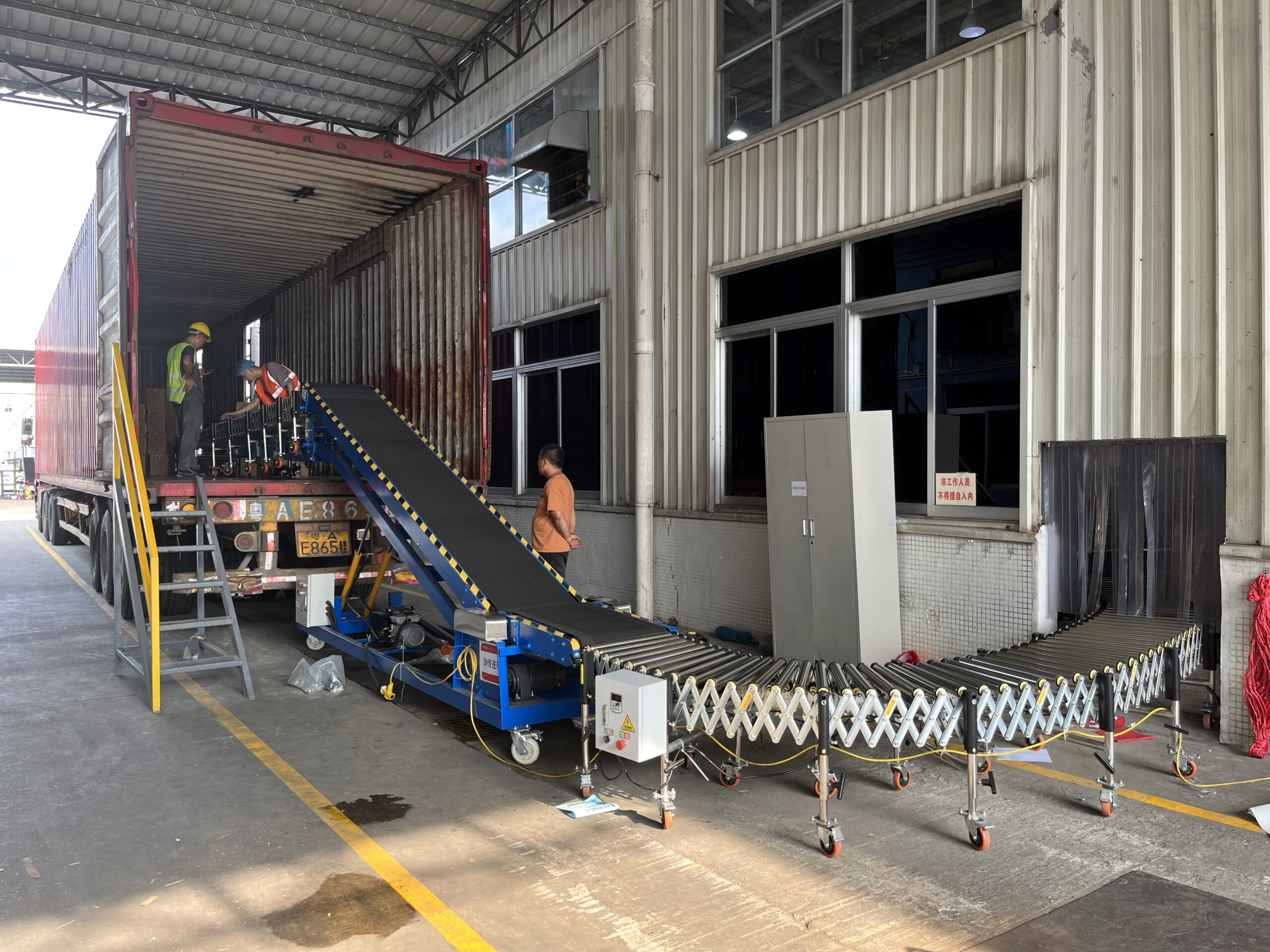

Always consult Naili’s product documentation or our engineering team when planning integrated systems to ensure compatibility and safety. Our conveyors are designed with standard interface heights and connection points to facilitate such integrations, but understanding the specific capabilities of each unit, especially regarding height adjustment and lifting, is crucial for your loading & unloading conveyor setup.
Day-to-Day Operation and Low-Maintenance Design
Naili’s Adjustable Roller Conveyor systems are designed for straightforward operation and minimal maintenance, ensuring a long service life of 5-10 years or more under normal usage.
Operational Simplicity:
- Setting up and adjusting the conveyor is typically a two-person job, requiring no specialized tools.
- Powered models feature intuitive control panels. Workers generally do not need specialized training.
- Locking casters ensure the conveyor remains stable during operation.
Maintenance Guidelines:
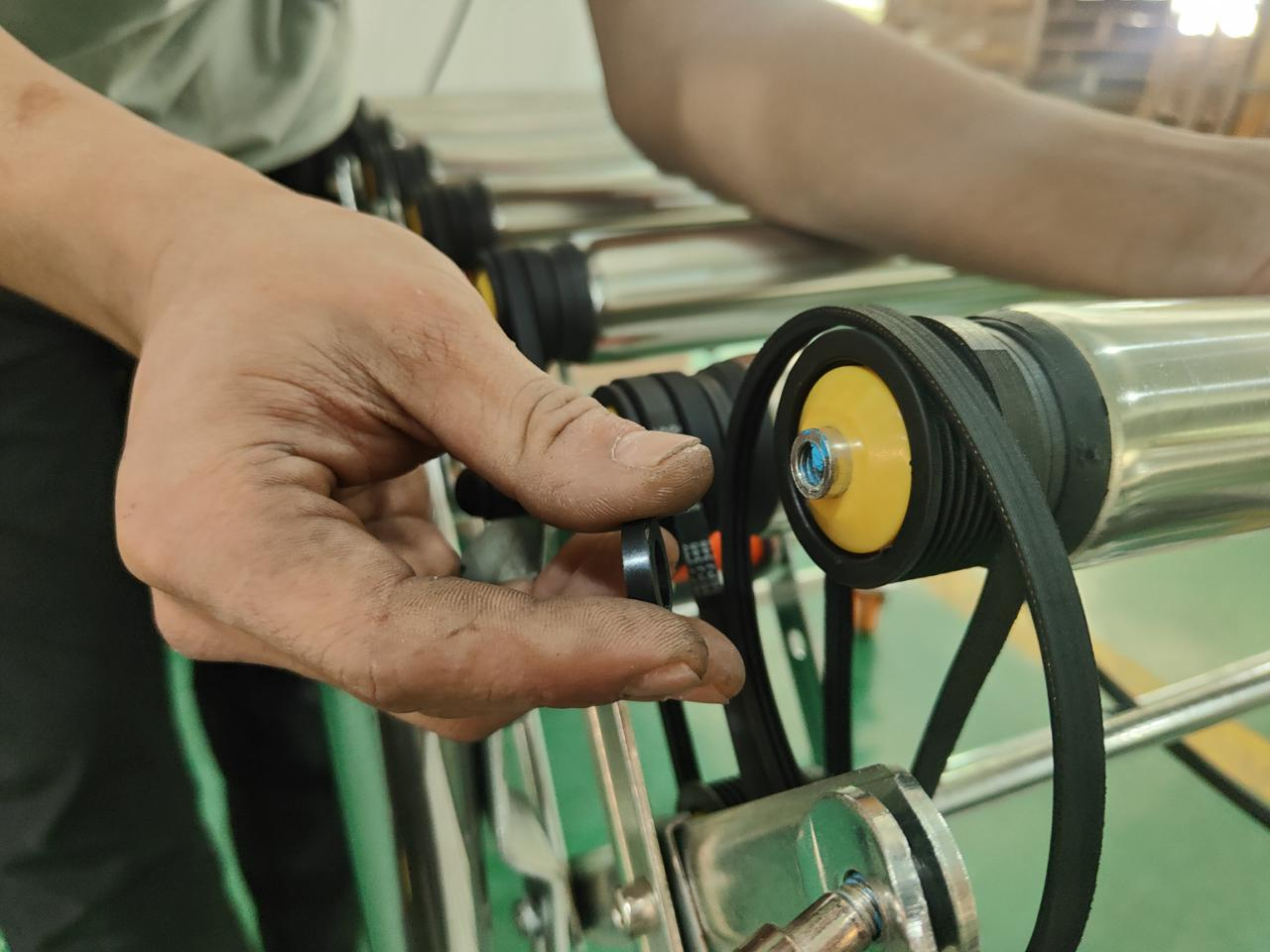

- Daily/Weekly Checks:Visually inspect rollers for free rotation and any damage.
- For powered units, check drive belt tension and look for any signs of wear.
- Ensure all connecting hardware and leg adjustments are secure.
- Periodic Maintenance:Clean roller surfaces to remove dust and debris.
- Lubricate bearings as per manufacturer recommendations (though many modern bearings are sealed for life).
- Inspect electrical connections and cables on powered units.
- Wear Parts:Drive belts (O-belts or Multi-wedge belts) on powered conveyors are the primary wear items. Under normal use, without overloading or jamming goods (which can cause premature failure), these belts offer long service lives. O-belts might last 6-12 months, while multi-wedge belts can last 12-18 months or longer. They typically do not require periodic replacement unless damaged due to misuse like overloading or allowing goods to accumulate and cause belt slippage (dry grinding).
- Rollers themselves are very durable. Damage to skate wheels can occur if non-flat bottomed items are frequently conveyed on a Gravity Skate Wheel Conveyor.
Please find more information for Maintenance Guidelines in this article: Flexible Roller Conveyor Maintenance Manual.
Cost-Effectiveness and Return on Investment
Investing in an Adjustable Roller Conveyor can yield significant returns through improved efficiency and reduced labor costs. While the initial investment varies based on type (gravity vs. powered), length, and features, the payback period is often attractive.
- Labor Savings: Can reduce the number of staff needed for loading/unloading tasks, as typically only two operators are needed – one at each end.
- Increased Throughput: Faster truck turnaround times. For example, a powered system might handle:Small parcels (up to 5kg): 3500-5000 pieces per hour
- Medium boxes (5-15kg): 2500-3500 pieces per hour
- Large cartons (15-30kg): 2000-2500 pieces per hour
- Reduced Product Damage: Smoother, more controlled movement minimizes drops and impacts.
- Improved Ergonomics: Less manual lifting and carrying reduces the risk of workplace injuries.
For operations handling over 1000 packages daily, systems like our Hydraulic Conveyor (e.g., Small Hydraulic Conveyor for smaller trucks, or Micro Hydraulic Conveyor for vans) and Telescopic Conveyor, often used in conjunction with adjustable roller sections, can achieve a return on investment within 6-12 months.
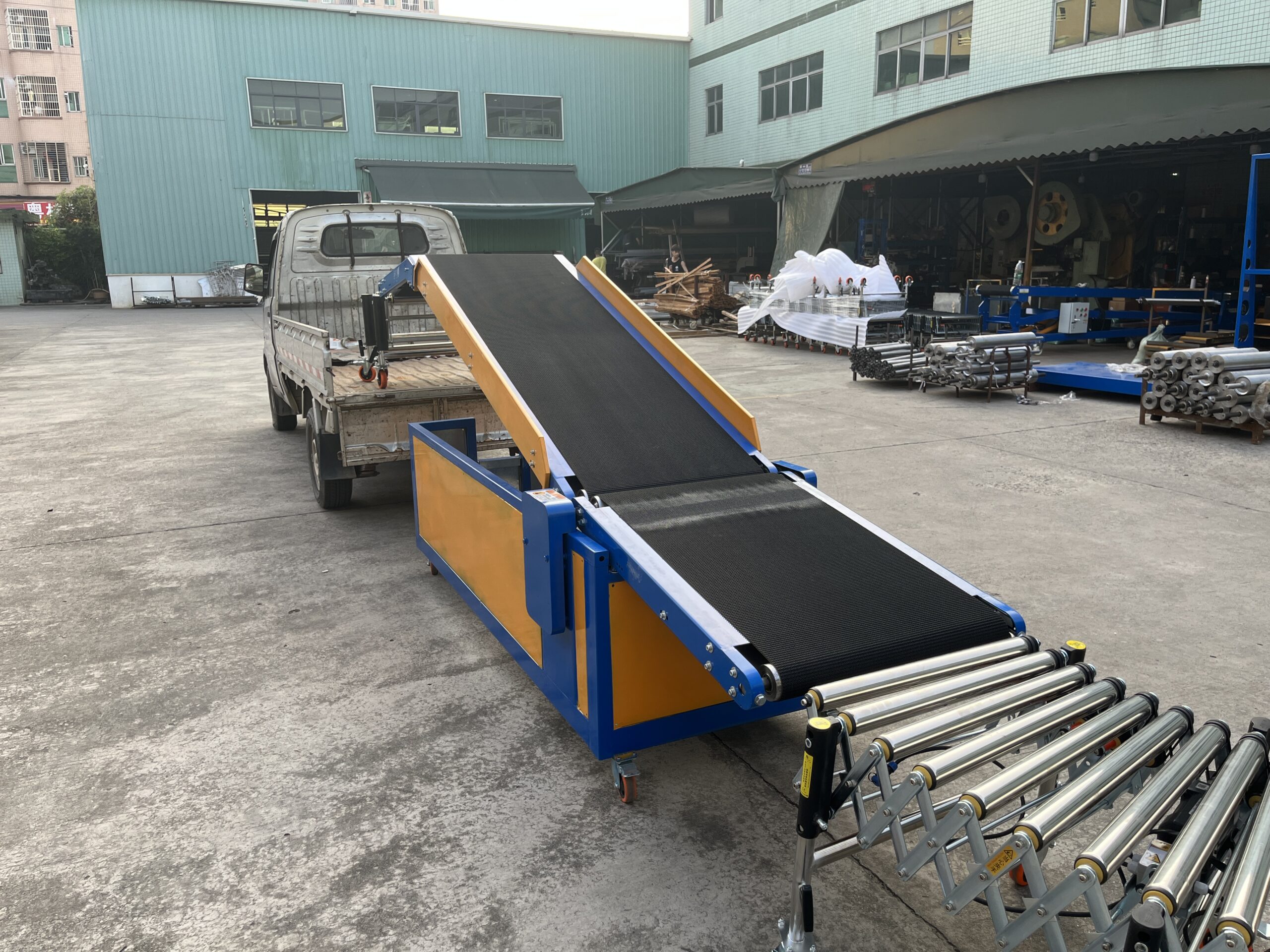

Prioritizing Safety in Conveyor Operations
Safety is a key consideration in any material handling environment. Naili Adjustable Roller Conveyor systems incorporate safety features, and operators should always adhere to best practices:
- Ensure casters are braked and the conveyor is stable before use.
- Do not exceed the rated load capacity of the conveyor.
- On powered models, ensure all guards are in place and use the emergency stop button when necessary.
- Prevent goods from jamming on powered rollers, as this can cause belt wear or motor strain.
- Maintain a safe operating speed and, for gravity conveyor systems, ensure the slope is not excessive to prevent runaway packages.
- Keep hands and loose clothing away from moving parts, especially on powered units.
- When using multi-section Telescopic Conveyors (three sections or more), ensure they are ground-locked during operation to prevent tipping due to leverage, especially if casters (electric or manual) are fitted.
Frequently Asked Questions (FAQs)
What is the ideal slope for a gravity adjustable roller conveyor?
Typically 2-5 degrees. Start with a shallower angle and increase if needed for lighter goods to ensure consistent flow.
Can an Adjustable Roller Conveyor reach into a truck by itself?
The adjustable legs allow for height matching at the dock or creating slopes. For significant lifting to truck bed height and extending deep inside, it’s best paired with a Hydraulic Conveyor which lifts the roller section.
Do I need specialized staff to operate these conveyors?
No, operation is simple and intuitive. Basic instruction on setup, adjustment, and safety is usually sufficient for workers.
What is the typical lifespan of an Adjustable Roller Conveyor?
With proper use and basic maintenance, Naili conveyors are robustly built and can last 5-10 years or more. Structural components rarely fail.
Can these conveyors be used outdoors?
While primarily designed for indoor use, gravity conveyor models with galvanized or (preferably) 201 stainless steel construction can be used outdoors with increased maintenance attention. Powered units require protection from the elements.
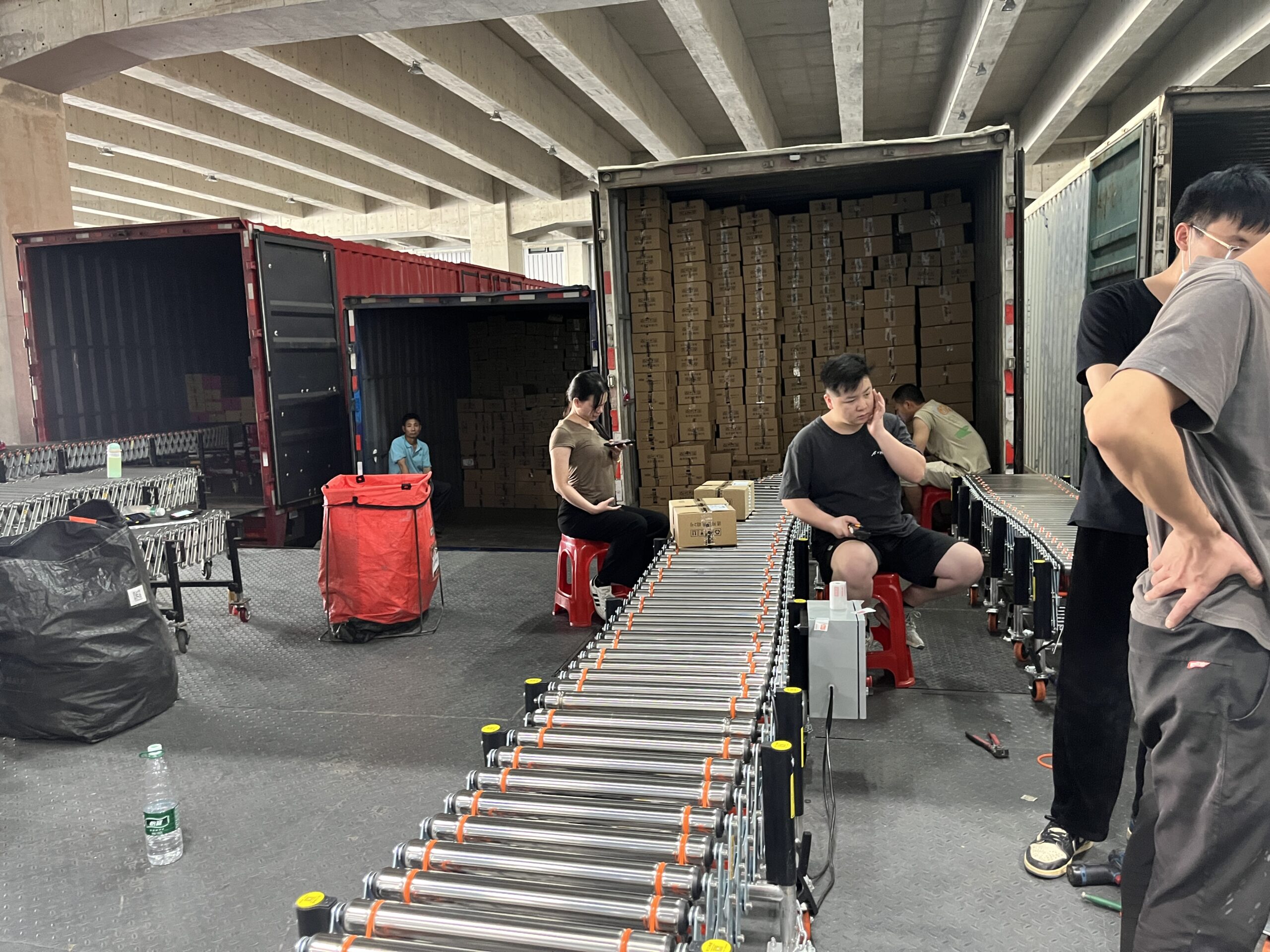

Transform Your Dock with Naili’s Adjustable Solutions
The Adjustable Roller Conveyor is more than just a piece of equipment; it’s a flexible, reliable, and efficient solution to the dynamic challenges of modern loading and unloading operations. By choosing the right type and configuration from Naili Conveyor’s extensive range, you can significantly reduce manual effort, speed up material flow, and create a safer, more productive workspace. Whether you’re handling a few hundred packages a day or several thousand, our adjustable systems, including the versatile flexible roller conveyor options, are designed to adapt to your needs and grow with your business.
Explore our detailed product pages for the Powered Rubber Roller Conveyor, Powered Roller Conveyor, and Gravity Roller Conveyor to find the perfect fit. Contact Naili Conveyor today for a consultation, and let our experts help you design an Adjustable Roller Conveyor system that optimizes your material handling processes and delivers tangible results. We provide detailed installation guidance to ensure you get up and running smoothly.
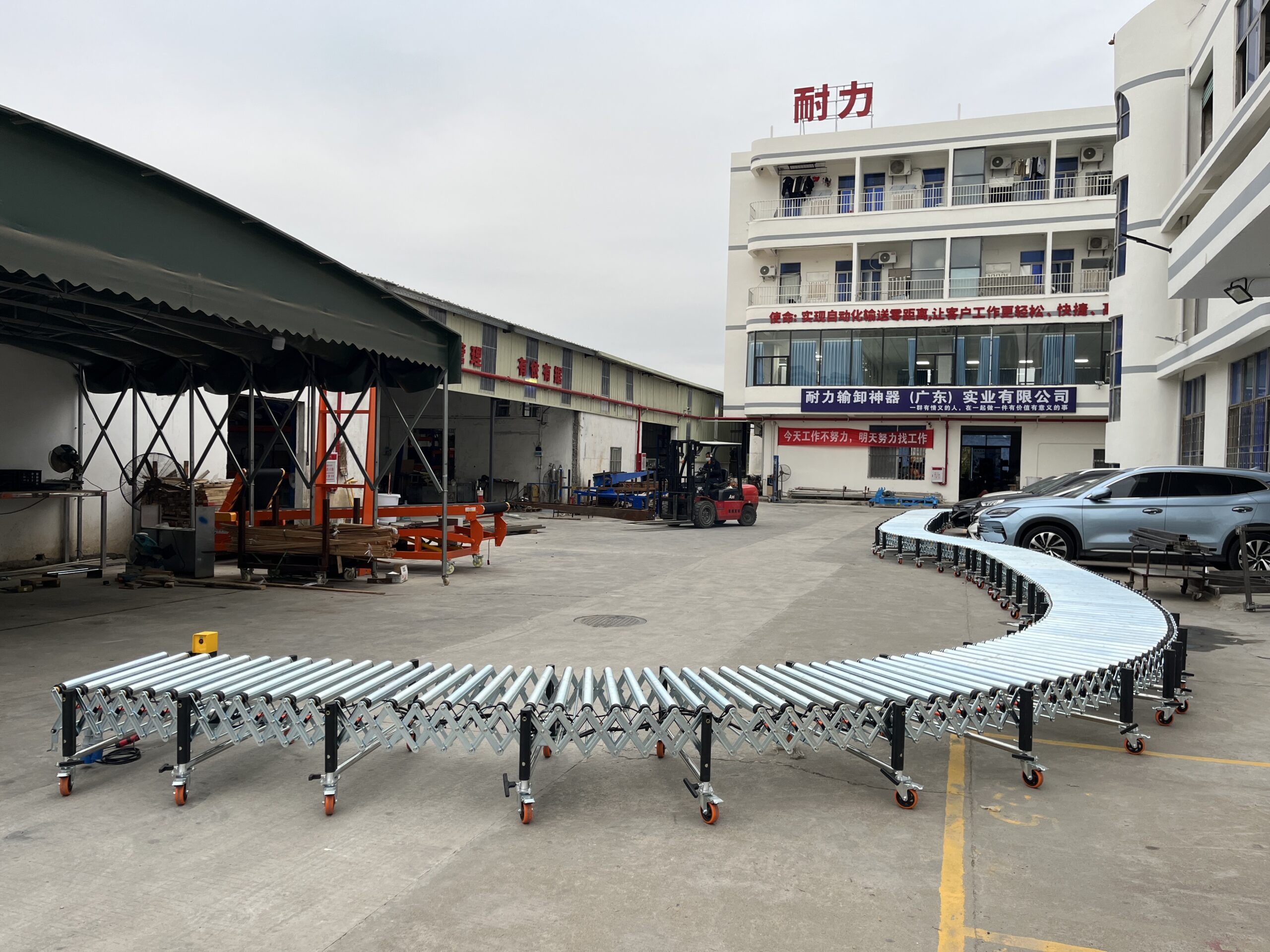

Table of Contents
Recent Posts
Optimize hardware store logistics with the right building supply conveyor systems. Our guide to tool distribution systems enhances retail warehouse automation for efficient operations.
Optimize your medical supply logistics with efficient gravity conveyor systems. Learn how to safely handle healthcare products while improving your hospital supply chain operations.
Discover how a sports equipment conveyor system can streamline your athletic gear logistics. Flexible conveyor solutions for all shapes and sizes of sporting goods.

